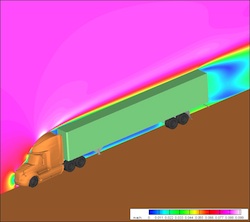East Bound And Down, Loaded Up And Truckin’
 Back in 1977 when the price of gas was around $0.60, no one gave a second thought to driving a Black Pontiac Trans AM or an 18-wheeler full of Coors across the Southeast from Texas to Georgia.
Back in 1977 when the price of gas was around $0.60, no one gave a second thought to driving a Black Pontiac Trans AM or an 18-wheeler full of Coors across the Southeast from Texas to Georgia.
Oh, what an impact 35 years of globalization, continued Mideast turmoil and inflation has had. Today you have multinational manufacturers, national labs and universities working every angle to make sexy new trucks that sip significantly less fuel.
Over the past few months I have become aware of or involved in three distinct efforts along the lines of fuel efficiency. While the Chevy Volt and Nissan Leaf may find its place in neighborhood garages, that battery, or even a few of them, would not have the power required to haul loads very far.
While I am not an expert in fuel efficiency, I do know that when it comes to saving it you basically have four options: increase the engine performance; reduce the vehicle weight; reduce the friction between the vehicle and the road; or improve aerodynamics to reduce the drag on the vehicle.
Technological improvements are continually occurring in vehicle and tire design, engine performance and lightweight materials. But how much sexier can you make a trailer that hauls Pringles for Proctor & Gamble, metal stampings for Mercedes, or clutches for Caterpillar? Well, as it turns out, a lot!
Aerodynamics and M&S
I remember back in the early 80s writing an article about the benefits of the space program on our economy. It was part of my submission for a scholarship towards my University of Illinois degree in Aerospace Engineering. I wrote about those aerodynamic fairings on truck cabs to direct the airflow over and around the trailers. Those fairings were the result of a 1978 NASA study and can be found on almost every truck today. Pretty cool. Check out the study, you will see a lot equations and physical test data. We have come a long way since the late 70’s.
In a recent article, Mercedes unveiled its new aerodynamic semi-trailer. The article claims this new design will afford savings of over 500 gallons of diesel fuel per year and a reduction in CO2 emissions on the order of five tons. That’s a lot of cost savings and quite a bit of green!
Another effort between BMI, Oak Ridge National Labs (ORNL) and NASA did a similar study on the effects of aerodynamics on truck fuel efficiency. In an article on the ORNL website it documents different design changes but similar overall improvements.
What both of these designs have in common is significant modeling and simulation horsepower, using computation fluid dynamics (CFD) modeling in combination with the massive hardware systems available. The catch is, Mercedes and ORNL have these tools available to them, and therefore these successes can be realized.
What is interesting is while the improvements were similar, the design proposals were significantly different. While Mercedes added side trim panels and a tapered rear end, BMI and ORNL developed add-on components that can be attached under the truck to better direct airflow around the axles and tires.
Industry Wide Implementation
How many of you tow anything? A boat, a camper, a trailer? Notice how much fuel you use? Now, most of that added fuel consumption is due to the added weight of what you are towing, but, as I stated earlier, it is also due to the added friction of additional tires on the trailer and the drastically reduced aerodynamics. What if we could apply some of these technologies to the trailers that many of us own or rent – those add-on features BMI and ORNL designed? They can be easily implemented after market.
The problem is that many of the suppliers of boat trailers and campers find themselves in niche markets and do not have anywhere near the resources of a Mercedes or BMI.
To address this challenge, NCMS is working with four member organizations – Ohio Supercomputer Center (OSC), TotalSim, Simafore and Nimbis Services – to develop a computation tool that will allow these niche designers and manufacturers unfamiliar to CFD, affordable access to the tools necessary to model airflow over a joint vehicle/trailer body. The idea is to help them to both reduce the overall weight and utilize novel geometries to increase aerodynamic efficiencies.
It may not sound like the sexiest application of M&S, but it is just another of the numerous ways NCMS is working to bring affordable modeling and simulation to the small and medium sized manufacturers in our nation.










